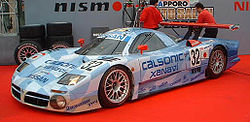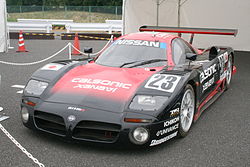- Nissan R390 GT1
-
Nissan R390 
Class Grand tourer race car Manufacturer Nissan Production 1997-1998 Predecessor Nissan R380 Successor Nissan R391 Layout mid engine/rear drive Engine 3.5L VRH35L twin turbo DOHC V8 Transmission 6-speed sequential Wheelbase 2,720.3 mm (107.1 in) Length 4,720 mm (185.8 in) Width 2,000 mm (78.7 in) Height 1,140 mm (44.9 in) Curb weight 1,029 kg (2,269 lb) Race car; 1,098 kg (2,421 lb) Road car Designer Tony Southgate The Nissan R390 GT1 was a racing car built for the 24 Hours of Le Mans in 1997 and 1998. It was built to race under the grand tourer style rules, requiring a homologated road version to be built, although only 2 R390 road cars were ever built, and one is stored at Nissan's Zama facility.
Contents
History
After returning to sports car racing in 1995, Nismo (Nissan Motorsport) had some measure of success with their Skyline GT-R LMs which had competed in the GT1 class. However, these cars were quickly outpaced by the influx of new manufacturers who were using loopholes in the GT regulations to build racing cars that bore little resemblance to their GT1 class competitors. This led to such machines as the Mercedes-Benz CLK GTR and Porsche 911 GT1, as well as the development of the McLaren F1 GTR. Nismo's Skyline GT-Rs therefore needed to be replaced with more purpose built machinery.
Turning to Tom Walkinshaw Racing (TWR), Nismo began development of the R390 GT1, named to follow in the tradition started in the 1960s with Nissan's R380. The first decision for Nismo and TWR was the choice of engine. The previous Skyline GT-R LMs had used the trusted RB26DETT Inline-6 motor, but the design was old for a racing car, employing an iron block which added weight. Nismo instead chose to resurrect an engine from the Nissan R89C, a racing car from the Group C era. Its engine, the VRH35Z, was a 3.5L V8 which used an aluminium block, as well as having a lower center of gravity and a better ability to be used as a stressed member over the RB26. Thus the engine was upgraded and designated VRH35L, and would produce approximately 641 hp (478 kW) at 6800 rpm.
The car's styling group was led by Ian Callum, and the mechanical and aerodynamic design led by Tony Southgate, both of Tom Walkinshaw Racing (TWR). Southgate was the designer of the Jaguar XJR-9 amongst other TWR Sportscars, which had won at Le Mans. Due to this, the R390 GT1 bears a resemblance to the Jaguar XJR-15, which was also developed by TWR and based on the XJR-9 and in fact used a modified version of the XJR15 monocoque. Development of the car was achieved in a small amount of time, especially due to not having to scratch-build an engine. Nismo and TWR also had to build a production version of the R390 GT1 in order to meet production regulations. Only two road-legal R390's were built, with one road car ending up in storage at Nissan's Zama, Kanagawa facility. The other was bought at an undisclosed auction by an unknown wealthy recipient and Nissan enthusiast.
For 1998 the R390 was modified, most notably in the extension of its rear bodywork to create increased "luggage space" in order to satisfy the ACO, after all three cars failed scrutineering at the 1997 event and had to be modified in order to be allowed to race. This subsequently lead to over-heating problems for the gearbox, and ultimately their failure during the race. Thus the "long tail" version was created, which boasted increased downforce thanks to the extended rear bodywork.
Racing results
The #23 1997 R390 GT1, the only one to finish at Le Mans '97.
Completed in time for the 1997 24 Hours of Le Mans, the three black and red R390 GT1s were fast in their first competition, with Martin Brundle taking pole position in May's pre-qualifying with a staggering time of 3.43.15. At the race itself, one R390 GT1 (#22) was able to qualify in 4th on the grid and 2nd in its class behind a Porsche 911 GT1, while its partners qualified 12th (#21) and 21st(#23). During the race both cars were able to perform admirably, but soon began to struggle with gearbox problems and, around halfway through the race, two of the three R390s (#21 & #22) finally succumbed to mechanical failure and were withdrawn. The third R390 was able to survive the rest of the race (albeit with two complete gearbox changes along the way) finishing 12th overall and 5th in class, although many laps down from the race winners. For 1998, Nissan returned, this time with four R390 GT1s. The cars were slightly upgraded, with more downforce able to be generated by a longer rear tail, and a new rear wing placement for less drag. Although Nissan was easily beaten in qualifying by Porsche, and Mercedes-Benz, Nissan was able to achieve considerable success in the race. As an achievement of its own, all four cars were able to finish the race. With this, Nissan was able to finish 3rd, 5th, 6th, and 10th overall, being beaten only by the Porsche 911 GT1.
Following the 1998 24 Hours of Le Mans, rules for the GT classes were changed, mostly to end the amount of manufacturers attempting to use loopholes. This meant Nissan was forced to abandon the R390 as it was no longer legal. Nissan instead turned to the LMP classes, developing the R391 prototype for 1999. This program would also be short lived and Nissan would end up leaving Le Mans.
A total of eight R390 GT1 race chassis were built over the two years of the program.
Road car
Only 2 R390 road cars were ever built, and one is stored at Nissan's Zama warehouse. The street-legal road car is capable of running 0-60 mph in 3.3 seconds and 0-100 mph in just 6.8 seconds. The 1/4 mile is accomplished in just 11.1 seconds at 134 mph (216 km/h). The top speed is 220 mph (350 km/h).
External links
- Supercars.net - 1998 Nissan R390 GT1
IMSA GTU (1979–1993) IMSA GTO/GTS (1981–1995) Group 5 (1979–1984) WSC / JSPC (1985–1992) IMSA GTP (1985–1993) Le Mans (1997–1999) R390 GT1 · R391
JGTC / Super GT (1993–2010) Skyline GT-R · Silvia · Fairlady Z (Z33) · GT-R ·
FIA GT1 (2010-) Categories:- Nissan vehicles
- Grand tourer racing cars
- 24 Hours of Le Mans race cars
- Rear mid-engine, rear-wheel drive vehicles
Wikimedia Foundation. 2010.

